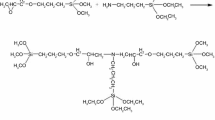Abstract
An ionic/nonionic polyurethane dispersion with high solid content and low viscosity with a complex hydrophilic chain-extending agent was prepared using isophorone diisocyanate as a hard segment and propylene oxide glycol as a soft segment. The complex hydrophilic chain-extending agent consisted of DPSA and BDSA. The effects of the molar ratio of DPSA/BDSA on the properties of the resultant polyurethane dispersions were studied. The morphologies and properties of the ionic/nonionic PU dispersions were examined using particle-size, TEM, and viscosity analyses. It was found that the ionic/nonionic dispersions possessed wide particle-size distributions due to the addition of the complex hydrophilic chain-extending agent. The ionic/nonionic PU dispersions possessed higher solid content than conventional WPU dispersions because the number and volume percentage of the large particles and small particles of the ionic/nonionic dispersions met the requirements for high solid content. It was observed that the solid content of the ionic/nonionic dispersion increased and then decreased with an increasing molar ratio of DPSA/BDSA. When the ratio ranged from 4:10 to 5:10, the solid content of the ionic/nonionic PU dispersion reached up to 55%. It was also noticed that the apparent viscosity of the ionic/nonionic polyurethane dispersion decreased with an increasing molar ratio of DPSA/BDSA. The complex hydrophilic chain-extending agent consisting of DPSA and BDSA enhanced the solid content and decreased the viscosity of the ionic/nonionic dispersions, which are very important for improving the properties and expanding the applications of PU dispersions. In addition, the ionic/nonionic polyurethane dispersion had good electrolyte-resistance properties, stability at both high and low temperatures, and storage stability.







Similar content being viewed by others
References
Guyot, A, Chu, F, Schneider, M, et al., “High Solid Content Latexes.” J. Appl. Polym. Sci., 10 1573–1615 (2002)
Li, Q, Sun, D, Wang, Y, “Synthesis of HDI–IPDI Based High Solid Content Aqueous Polyurethane Dispersion and Study on the Micromorphology of the Dispersion.” Polym. Mater. Sci. Eng., 23 59–62 (2007)
Liu, JP, Wang H, Shen LI, Wang XP, “Advances in Research on High-Solid Content Polymer Emulsion.” China Adhes., 27 32–35 (2006)
Mequanint, K, Sanderson, R, “Nano-Structure Phosphorus-Containing Polyurethane Dispersions: Synthesis and Crosslinking with Melamine Formaldehyde Resin.” Orig. Polym., 44 2631–2639 (2003)
Cakic, SM, Stamenkovic, JV, Djordjevic, DM, et al., “Synthesis and Degradation Profile of Cast Films of PPG–DMPA–IPDI Aqueous Polyurethane Dispersions Based on Selective Catalysts.” Polym. Degrad. Stab., 94 2015–2022 (2009)
Sun, DC, Huang, ZY, “Synthesis and Characterization of Anionic/Non-Ionic Type High Solid Content Polyurethane Dispersion Based on Sulfonate and Monofunctional Polyethylene Oxide Polyether.” J. Chem. Ind. Eng., 60 497–501 (2009)
García-Pacios, V, Costa, V, Colera, M, et al., “Effect of Polydispersity on the Properties of Waterborne Polyurethane Dispersions Based on Polycarbonate Polyol.” Int. J. Adhes. Adhes., 30 456–465 (2010)
García-Pacios, V, Iwata, Y, Colera, M, et al., “Influence of the Solids Content on the Properties of Waterborne Polyurethane Dispersions Obtained with Polycarbonate of Hexanediol.” Int. J. Adhes. Adhes., 31 787–794 (2011)
Wei, XL, Zhang, FX, Xiao, ZL, “Preparation and Property Study of High-Solid Content and Low-viscosity Polyurethane Microemulsions.” Acta Polym. Sin., 1 28–34 (2009)
Kim, KB, Shin, HJ, “Modification of Waterborne Polyurethane by Forming Latex Interpenetrating Polymer Networks with Acrylic Rubber.” Colloid Polym., 280 716–724 (2002)
Jofre-Reche, JA, García-Pacios, V, et al., “Role of the Interactions Between Carbonate Groups on the Phase Separation and Properties of Waterborne Polyurethane Dispersions Prepared with Copolymers of Polycarbonate Diol.” Prog. Org. Coat., 12 199–211 (2015)
Li, QA, Dong, CS, Yu, XW, “Study on the Synthesis for Poly(Lactic Acid) by Direct Condensation Polymerization.” China Adhes., 8 59–64 (2007)
Kang, YS, Kim, BK, “High Solid and High Performance UV Cured Waterborne Polyurethanes.” Colloids Surf. A, 10 58–63 (2010)
Lee, HT, Wu, SY, “Effect of Sulfonated Polyol on the Properties of the Resultant Aqueous Polyurethane Dispersions.” Colloids Surf. A, 276 176–185 (2006)
Wei, XL, Zhang, FX, Xiao, ZL, “Study on High-Solid Content Si/PU Polyurethane Dispersion with PES/PPG Composite Soft Segment.” J. Appl. Polym. Sci., 5 1–5 (2012)
Rahman, MM, Yoo, HJ, Jung, C, “Synthesis and Characterization of a Clay/Waterborne Polyurethane/Clay Nanocomposite—Effect on Adhesive Strength.” Macromol. Symp., 250 252–258 (2007)
Kuan, H-C, Chuang, W-P, Ma, C-C, “Synthesis and Characterization of a Clay/Waterborne Polyurethane Nano-Composite.” J. Mater. Sci., 40 180–186 (2005)
Lee, D, Lee, S-H, Kim, S, “Micro-Phase-Separation Behavior of Amphiphilic Polyurethanes Involving Poly(Ethylene Oxide) and Poly(Tetramethylene Oxide).” J. Polym. Sci., 41 20–25 (2003)
Acknowledgments
This work was partially supported by the Chemical Additives and Surfactants Key Laboratory of Sichuan Universities (Projects 2015JXY02 and 2014JXY04), the Sichuan University Talents Project (Projects 2014RC14 and 2015RC55), and the Sichuan Province Department of Education (Project 16ZB0254). The authors also thank all project team members for providing performance testing of the products in this study.
Author information
Authors and Affiliations
Corresponding author
Rights and permissions
About this article
Cite this article
Zhang, F., Wei, X. Study of ionic/nonionic polyurethane dispersions with high solid content and low viscosity using a complex hydrophilic chain-extending agent. J Coat Technol Res 15, 141–148 (2018). https://doi.org/10.1007/s11998-017-9965-y
Published:
Issue Date:
DOI: https://doi.org/10.1007/s11998-017-9965-y




